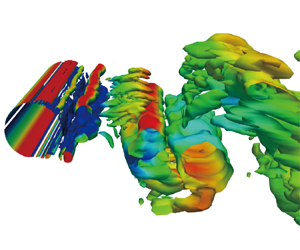Crossref Citations
This article has been cited by the following publications. This list is generated based on data provided by
Crossref.
Yan, Lei
Li, Yuerong
Hu, Gang
Chen, Wen-li
Zhong, Wei
and
Noack, Bernd R.
2023.
Stabilizing the square cylinder wake using deep reinforcement learning for different jet locations.
Physics of Fluids,
Vol. 35,
Issue. 11,
Vasanth, Joel
Rabault, Jean
Alcántara-Ávila, Francisco
Mortensen, Mikael
and
Vinuesa, Ricardo
2024.
Multi-agent Reinforcement Learning for the Control of Three-Dimensional Rayleigh–Bénard Convection.
Flow, Turbulence and Combustion,
Dong, Xinhui
Wang, Zhuoran
Lin, Pengfei
Wang, Qiulei
and
Hu, Gang
2024.
An interactive platform of deep reinforcement learning and wind tunnel testing.
Physics of Fluids,
Vol. 36,
Issue. 11,
Zhang, Zeyu
Li, Shanwu
Feng, Hui
Zhou, Xuxi
Xu, Nan
Li, Hui
Laima, Shujin
and
Chen, Wenli
2024.
Machine learning for bridge wind engineering.
Advances in Wind Engineering,
Vol. 1,
Issue. 1,
p.
100002.
Kim, Innyoung
Jeon, Youngmin
Chae, Jonghyun
and
You, Donghyun
2024.
Deep Reinforcement Learning for Fluid Mechanics: Control, Optimization, and Automation.
Fluids,
Vol. 9,
Issue. 9,
p.
216.
Chen, Jie
Zong, Haohua
Song, Huimin
Wu, Yun
Liang, Hua
and
Xiang, Jiawei
2024.
A field programmable gate array-based deep reinforcement learning framework for experimental active flow control and its application in airfoil flow separation elimination.
Physics of Fluids,
Vol. 36,
Issue. 9,
Yan, Lei
Zhang, Xingming
Song, Jie
and
Hu, Gang
2024.
Active flow control of square cylinder adaptive to wind direction using deep reinforcement learning.
Physical Review Fluids,
Vol. 9,
Issue. 9,
Zhang, Jin
Xue, Jianyang
and
Cao, Bochao
2024.
Improving agent performance in fluid environments by perceptual pretraining.
Physics of Fluids,
Vol. 36,
Issue. 12,
Gong, Tianchi
Wang, Yan
and
Zhao, Xiang
2024.
Active control of transonic airfoil flutter using synthetic jets through deep reinforcement learning.
Physics of Fluids,
Vol. 36,
Issue. 10,
Ren, Feng
Wen, Xin
and
Tang, Hui
2024.
Model-Free Closed-Loop Control of Flow Past a Bluff Body: Methods, Applications, and Emerging Trends.
Actuators,
Vol. 13,
Issue. 12,
p.
488.
Yan, Lei
Li, Yuerong
Liu, Bo
and
Hu, Gang
2024.
Aerodynamic force reduction of rectangular cylinder using deep reinforcement learning-controlled multiple jets.
Physics of Fluids,
Vol. 36,
Issue. 2,
Li, Xin
and
Deng, Jian
2024.
Active control of the flow past a circular cylinder using online dynamic mode decomposition.
Journal of Fluid Mechanics,
Vol. 997,
Issue. ,
Xia, Chengwei
Zhang, Junjie
Kerrigan, Eric C.
and
Rigas, Georgios
2024.
Active flow control for bluff body drag reduction using reinforcement learning with partial measurements.
Journal of Fluid Mechanics,
Vol. 981,
Issue. ,
Mishra, Awakash
Rengarajan
Bhatt, Rahul
and
Prince, P. Blessed
2025.
Proceedings of the 5th International Conference on Data Science, Machine Learning and Applications; Volume 2.
Vol. 1274,
Issue. ,
p.
638.
Sofos, Filippos
and
Drikakis, Dimitris
2025.
A review of deep learning for super-resolution in fluid flows.
Physics of Fluids,
Vol. 37,
Issue. 4,
Yan, Lei
Wang, Qiulei
Hu, Gang
Chen, Wenli
and
Noack, Bernd R.
2025.
Deep reinforcement cross-domain transfer learning of active flow control for three-dimensional bluff body flow.
Journal of Computational Physics,
Vol. 529,
Issue. ,
p.
113893.
Li, Hao
Cornejo Maceda, Guy Y.
Li, Yiqing
Tan, Jianguo
and
Noack, Bernd R.
2025.
Toward human-interpretable, automated learning of feedback control for the mixing layer.
Physics of Fluids,
Vol. 37,
Issue. 3,
Dong, Xiang-rui
You, Sun-yu
Wang, Qi
Zhu, Jia-hao
and
Jin, Zhi-hao
2025.
Research on vorticity driven reward for active flow control over airfoil based on deep reinforcement learning.
Journal of Hydrodynamics,
Zong, Haohua
Wu, Yun
Li, Jinping
Su, Zhi
and
Liang, Hua
2025.
Closed-loop supersonic flow control with a high-speed experimental deep reinforcement learning framework.
Journal of Fluid Mechanics,
Vol. 1009,
Issue. ,
Moslem, Foad
Jebelli, Mohammad
Masdari, Mehran
Askari, Rasoul
and
Ebrahimi, Abbas
2025.
Deep reinforcement learning for active flow control in bluff bodies: A state-of-the-art review.
Ocean Engineering,
Vol. 327,
Issue. ,
p.
120989.

 $(Re) = 100$ and significantly mitigates lift coefficient fluctuations. Hence, DF-DRL allows the deployment of sparse sensing of the flow without degrading the control performance. This method also exhibits strong robustness in flow control under more complex flow scenarios, reducing the drag coefficient by 32.2 % and 46.55 % at
$(Re) = 100$ and significantly mitigates lift coefficient fluctuations. Hence, DF-DRL allows the deployment of sparse sensing of the flow without degrading the control performance. This method also exhibits strong robustness in flow control under more complex flow scenarios, reducing the drag coefficient by 32.2 % and 46.55 % at  $Re =500$ and 1000, respectively. Additionally, the drag coefficient decreases by 28.6 % in a three-dimensional turbulent flow at
$Re =500$ and 1000, respectively. Additionally, the drag coefficient decreases by 28.6 % in a three-dimensional turbulent flow at  $Re =10\,000$. Since surface pressure information is more straightforward to measure in realistic scenarios than flow velocity information, this study provides a valuable reference for experimentally designing the active flow control of a circular cylinder based on wall pressure signals, which is an essential step toward further developing intelligent control in a realistic multi-input multi-output system.
$Re =10\,000$. Since surface pressure information is more straightforward to measure in realistic scenarios than flow velocity information, this study provides a valuable reference for experimentally designing the active flow control of a circular cylinder based on wall pressure signals, which is an essential step toward further developing intelligent control in a realistic multi-input multi-output system.